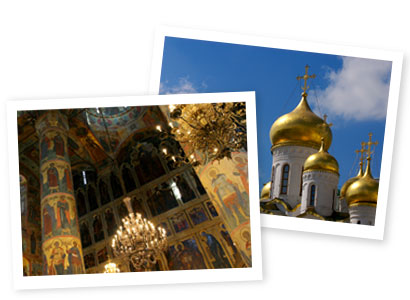 |
|
|
 UK: 0845 521 2910 UK: 0845 521 2910 | |
 USA: 1 8665 224308 USA: 1 8665 224308 | |
 AUS: 1300 654 861 AUS: 1300 654 861 | |
 expert@trans-siberian.co.uk expert@trans-siberian.co.uk | |

Destinations
Email an expert
All of our trips have a pre-arranged schedule. However if you would like to customise your journey, please let us know how by either calling us on 0845 521 2910 or emailing us
Moscow
Moscow began as one of many medieval trading cities to the north of then-capital Kiev. When the Mongolians ransacked Kiev (1240s ff) Moscow manoeuvered politically to position itself as a safe haven for the Mitropolitan (Supreme Archbishop) and thus become the new capital city – although it was only able to utilise this power from the 1480s ff, after the Mongolians and their vassals had been driven out of Russia. Beginning from that time (all civic building projects had been put on hold during the two centuries of Mongolian rule) Moscow rebuilt itself almost entirely, building a powerful new citadel at the heart of the city – the Moscow Kremlin. Moscow lost its role as capital from 1703-1918, during the time when St Petersburg was Imperial capital. The main reason that Moscow became capital once again in 1918 (ie during WW1) was strategic – the German army had advanced into the city suburbs of St Petersburg and it was feared they could take the city. The soviet government retreated to the safety of Moscow, and moved the role of capital to Moscow once again...
Moscow has remained Russia's capital ever since (rather to the annoyance of St Petersburgers, with whom there is an ongoing good-natured rivalry on this matter. And in fact on most other matters too, from “where the purest form of Russian is spoken” through to football). Since the implosion of the USSR (in 1990) Moscow has been considerably rebuilt and renovated – many ugly soviet buildings have been replaced with ugly non-soviet buildings. Moscow's architecture is dominated by C19th buildings – the reason is that planning regulations were less strict than in St Petersburg at the time, and many Russians with money preferred to live in more liberal Moscow than the strict military-system rule found in St Petersburg... which discriminated against many classes of wealthy people (“self-made-men”, industrialists, members of any religious groups outside the Orthodox Church, jews, muslims, Armenians, Georgians etc were all prohibited from building houses in tsarist-era St Petersburg – so they settled in Moscow). For this reason Moscow's architecture strongly resembles that of Europe's other C19th-built city – Paris, and in fact often the architects were the same.
The hidden secret of Moscow is the small areas of the centre where the tour-buses don't penetrate – here are the elegant streets around Patriarch's Ponds (the setting for the favourite muscophile Stalin-era-banned novel, “The Master & Margarita”), the Moscow Conservatoire, and the mansions of Moscow's C19th aristocrats along Ostozhenka. The enthusiastic (or those on our walking tours) will find the small private museums which are the former homes of Maxim Gorky or Count Lev Tolstoy, or the streets where the fictional “Dr Zhivago” took refuge.
Don’t miss in Moscow…
The Moscow Kremlin is a don't-miss visit
... the original medieval citadel of the city, enclosed within colossal C16th defensive walls from a time when the return of the Mongols was still a realistic threat. Within the Kremlin are the medieval cathedrals which marked the events of the lives of the Tsars – one for coronations, another for burials, another for weddings, yet another as the Tsarevna's private chapel, and one rebuilt specially for Ivan The Terrible... he'd been excommunicated and couldn't go in, but as Head Of The Church had to attend services... so a special stairway allowed him to peek in through an upper window without entering the church.
The Treasure Of The Tsars
Also within the Kremlin, but deserving a separate visit, is the Armoury Collection – which isn't (ehem!) a collection of armour at all, but the Treasure Of The Tsars – housed for safe-keeping in the most secure building in the Kremlin, where the weapons used to be stored. Timed/dated entrance applies always for this unique collection of regal apparel, crowns and coronets, the state coronation carriages, precious gifts from foreign monarchs, and most famously the Faberge Eggs.
The Pushkin Museum Of Fine Arts
... is not related to the author Pushkin (although named after him) – it displays most of the western art housed in Moscow collections (including Italian & French renaissance & baroque, and the French Impressionists).
The State Tretyakov Gallery houses all of the Russian old masters – a unique collection of priceless value.
The Kolomenskoe Estate
This was once a countryside palace when Moscow was much smaller – now it's within the suburbs and easily visited by metro. The palace itself was destroyed in a fire in the C19th, but the outbuildings and churches survive, in a large park that's perfect for picnics afterwards.
Archangelskoe Estate is 22km from Moscow – but on a regular bus service and worth the visit.. it was the palace of the Yusupovs, Russia's richest aristocrats, who were even richer than the Tsars. An elaborate baroque park with follies, mock temples, fountains and even a private opera-house (although this is under renovation) await summertime visitors.
Red Square & Lenin's Mausoleum
... come early-morning for the Mausoleum queue (last admission 12:30), or come in the afternoons to stroll in Red Square. Red Square is kept shut whilst the Mausoleum is open – in case protesters try an attack on Lenin? Afterwards visit St Basil's Cathedral (not what you expect inside – a warren of small passages and chapels. For the grand impressive cathedral interior you need to head for Assumption Cathedral, in the Kremlin). Then pop into GUM.. not a “department store” as popularly claimed, but a C19th shopping arcade that now features major world luxury-brand shopping... alongside some more normal shops and a bit of soviet grot for old time's sake. More normal shopping is adjacent in the Manege Shopping Mall – three floors of shops sunk under Manege Square (including a Food Court – for budget-priced lunching near Red Square).

Novodeivichy – “New Maiden” Convent
A C16th convent which was effectively a very smart-looking prison for female wrongdoers amongst the nobility – Peter the Great forced his wife into becoming a nun here... as an alternative to being beheaded for high treason for leading an armed revolt against him. Massive Kremlin-style walls enclose the group of onion-domed churches and chapels. Notorious enemies of the State were also buried here – to prevent their graves being desecrated by vigilantes. In a Moscow suburb and an easy Metro journey. An attractive park and lake behind the convent's walls make a nice walk afterwards. Adjacent – for those with an interest in Russia's history – is a civic cemetery famous for the graves of writers, composers, politicians, and military leaders. Everyone from Lenin's brother (and, err, Lenin's mistress too) to disgraced soviet-era reformer Nikita Kruschev are buried here.., but Russians will flock to the tomb of 1970s cult banned singer Vladimir Vysotsky.
The Moscow Metro
Perhaps the world’s most famous mass-transit system, known worldwide for the extraordinary and ostentatious style of the first generation of stations.. conceived as “palaces for the people” by the new soviet administration. The stations on the Circle Line (coloured brown on metro maps) are some of the most famous (particularly Kievskaya, Novoslobodskaya, and Komsomolskaya), and other central stations like Okhotny Ryad, Mayakovskaya and especially Ploschad’ Revolutsii (“Revolution Square”) are all on the must-see list. By way of variety try to see Vorobievy Gory (“Sparrow Hills”) as an example of what the latest generation of stations look like.
Arbat Street
... although frankly it’s a tourist-trap, it’s still worth taking a quick look – although the same souvenirs can be found cheaper and in better selections at the weekend fleamarket adjacent to Izmailovsky Park metro station (Sat/Sun only, except for the last two weeks of December, when it opens daily in the run-up to New Year).
Gorky Park
... is famous from the name of the cold-war spy thriller novel, but in fact it’s an entertainment park offering fairground rides and other attractions – open until midnight every night. Ice-skating in winter, too.
The Bolshoi Theatre
... has performances of ballet and opera from mid-Sept to end-June each year (closed July & August – like most world ballet theatres). However, there is regularly a Summer Ballet Season given at the Molodezhny Theatre adjacent to the Bolshoi. Moscow has no less than five professional opera and ballet companies – don’t ignore the chance to see (and at lower prices than the Bolshoi) the marvelous performances at Novaya Opera (“New Opera” – actually it’s completely traditional and not very new at all) or Stanislavsky-Muzykalny (who also have ballet as well as opera). Fans of new and avant-garde theatre will flock to Helikon Opera, the cult-following new-style opera house in town – when they are not touring abroad (they are so loved in France their Artistic Director was knighted in Paris).
Two Circuses.
There are two circuses in Moscow – the Nikulin Circus (old-style) at Tsvetnoy Boulevard metro, and the New Circus (Vegas-style) at Univeristet metro.











